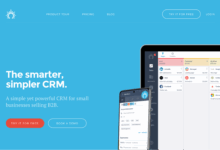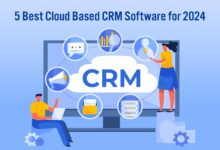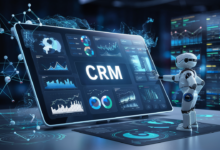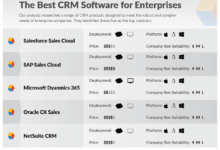CRM for Sales and Marketing Automation
CRM for Sales and Marketing Automation represents a powerful synergy, streamlining processes and boosting efficiency. By integrating sales and marketing efforts within a unified platform, businesses can achieve a level of coordinated action previously unattainable. This integration fosters better lead management, more effective nurturing campaigns, and ultimately, a higher return on investment. This exploration delves into the key features, implementation strategies, and future trends of this transformative technology.
This powerful combination allows for a holistic view of the customer journey, from initial contact to final conversion. Marketing teams can leverage the CRM to track campaign effectiveness and personalize messaging, while sales teams benefit from a centralized repository of customer data, enabling them to tailor their approach and close deals more efficiently. The result is a more data-driven, responsive, and ultimately successful business operation.
Defining CRM for Sales and Marketing Automation
A Customer Relationship Management (CRM) system, when designed for both sales and marketing automation, acts as a central hub for managing all customer interactions. It streamlines processes, improves team collaboration, and ultimately boosts sales and marketing effectiveness. This integrated approach moves beyond simply tracking leads and sales to encompass a holistic view of the customer journey.
A CRM system designed for both sales and marketing offers a comprehensive suite of tools far beyond those found in a sales-only CRM. Core functionalities include contact management, lead management, sales pipeline tracking, opportunity management, marketing campaign management, email marketing, social media integration, reporting and analytics, and customer service tools. These capabilities allow businesses to manage the entire customer lifecycle, from initial contact to post-sale support.
Key Differences Between Sales-Only and Integrated CRMs
A sales-only CRM primarily focuses on managing the sales process. It tracks leads, opportunities, and sales activities, providing sales teams with the tools they need to close deals. However, it lacks the marketing automation features found in an integrated system. An integrated CRM, on the other hand, adds sophisticated marketing automation capabilities. This includes features like marketing campaign management, email marketing automation, lead scoring, and marketing analytics, enabling the marketing team to nurture leads, segment audiences, and personalize communications. This integrated approach provides a single source of truth for both sales and marketing, eliminating data silos and fostering better collaboration.
Examples of Sales and Marketing Collaboration Using a Unified CRM
Effective collaboration between sales and marketing teams is significantly enhanced through a unified CRM. For example, the marketing team can segment customers based on their behavior and engagement with marketing campaigns. This segmented data is then shared with the sales team, allowing them to tailor their sales approach to specific customer profiles. Sales teams can provide feedback on the effectiveness of marketing campaigns by tracking which leads generated by specific campaigns converted into sales. This feedback loop allows for continuous optimization of marketing efforts. Another example involves real-time lead routing. When a lead interacts with a marketing campaign (e.g., downloads a whitepaper), the CRM can automatically route that lead to the appropriate sales representative, ensuring timely follow-up and maximizing conversion opportunities. This integrated system fosters a shared understanding of customer interactions, leading to a more efficient and effective sales and marketing process.
Benefits of Integrated Sales and Marketing Automation
Integrating sales and marketing automation through a CRM system offers significant advantages, streamlining workflows and boosting overall efficiency. By connecting these previously siloed functions, businesses can achieve a more unified and effective approach to customer engagement, leading to improved conversion rates and increased revenue. This integration eliminates redundancies, improves data accuracy, and fosters better collaboration between sales and marketing teams.
The improved efficiency stems from the automation of repetitive tasks. Marketing automation handles tasks such as email marketing campaigns, lead nurturing, and social media posting, freeing up marketing personnel to focus on strategic initiatives. Similarly, sales automation automates tasks like lead scoring, opportunity management, and sales reporting, allowing sales representatives to spend more time building relationships with potential clients. This automation reduces manual effort, minimizes errors, and allows for quicker response times to leads and customer inquiries.
Increased Sales Efficiency and Revenue Generation
Automating sales processes through a CRM significantly improves efficiency and boosts revenue. For instance, lead scoring automatically prioritizes high-potential leads, ensuring that sales representatives focus their efforts on the most promising prospects. Automated follow-up emails and reminders ensure that leads are consistently nurtured, increasing the likelihood of conversion. This targeted approach leads to a higher conversion rate and ultimately, increased revenue. A study by Nucleus Research found that high-performing sales organizations using sales automation see a 14.5% increase in sales productivity.
Improved Marketing ROI
Marketing automation within a CRM allows for detailed tracking and measurement of marketing campaigns. This data-driven approach allows businesses to optimize campaigns in real-time, maximizing their return on investment (ROI). For example, a company could A/B test different email subject lines to determine which performs best, leading to higher open and click-through rates. Another example is personalized email marketing, which can dramatically increase engagement and conversion rates. A study by MarketingSherpa found that personalized emails generate six times higher transaction rates.
Comparison of Integrated vs. Separate Systems
| Feature | Integrated CRM (Sales & Marketing Automation) | Separate Sales & Marketing Tools |
|---|---|---|
| Data Integration | Seamless data flow between sales and marketing; single source of truth. | Data silos; requires manual data entry and reconciliation; potential for inconsistencies. |
| Workflow Efficiency | Automated workflows; reduced manual effort; improved team collaboration. | Fragmented workflows; increased manual effort; potential for bottlenecks and delays. |
| Reporting and Analytics | Comprehensive, unified reporting and analytics; provides a holistic view of performance. | Separate reports from different tools; difficult to get a complete picture of performance. |
| Cost-Effectiveness | Often more cost-effective in the long run due to increased efficiency and reduced manual effort. | Higher overall cost due to multiple software licenses and integration challenges. |
Key Features of a Robust CRM System
A robust CRM system is the backbone of any successful sales and marketing strategy. It’s more than just a contact list; it’s a centralized hub for managing interactions, automating processes, and driving revenue growth. The features it offers directly impact efficiency, customer relationships, and ultimately, the bottom line. Choosing the right CRM requires careful consideration of the specific needs of your business.
The functionality offered by various CRM platforms varies significantly. Some are designed for small businesses with basic needs, while others cater to large enterprises with complex requirements. Factors such as scalability, integration capabilities, and user-friendliness all play a crucial role in determining the suitability of a particular CRM. Popular platforms such as Salesforce, HubSpot, Zoho CRM, and Microsoft Dynamics 365 each offer a unique blend of features, catering to different business sizes and industries. Understanding these differences is critical to selecting the best fit.
Lead Management Capabilities
Effective lead management is paramount for sales success. A robust CRM should streamline the entire lead lifecycle, from initial capture to conversion. This involves features that facilitate lead scoring, assignment, and tracking, ensuring no potential customer slips through the cracks. These features directly impact sales conversion rates and the efficiency of sales teams.
- Lead Scoring: Automatically assigns values to leads based on predefined criteria (e.g., website activity, email engagement, demographics), prioritizing high-potential prospects.
- Lead Routing: Intelligently directs leads to the most appropriate sales representative based on factors like territory, industry, or expertise.
- Lead Tracking: Provides a comprehensive view of each lead’s journey, including interactions, progress through the sales pipeline, and conversion status.
Sales Automation Features
Automating repetitive sales tasks frees up valuable time for sales representatives to focus on building relationships and closing deals. This increased efficiency translates directly to higher productivity and revenue.
- Sales Pipeline Management: Visual representation of the sales process, allowing for easy tracking of deals at each stage.
- Automated Email Sequences: Pre-defined email sequences triggered by specific events (e.g., lead submission, website visit), nurturing leads and moving them through the sales funnel.
- Sales Forecasting: Predictive analytics based on historical data and current pipeline activity, allowing for more accurate sales projections.
Marketing Automation Tools
Integrating marketing and sales automation within a single CRM platform creates a seamless customer journey. This coordinated approach enhances brand consistency, improves customer engagement, and increases conversion rates.
- Campaign Management: Tools for planning, executing, and tracking marketing campaigns across multiple channels (e.g., email, social media, advertising).
- Marketing Analytics: Detailed reports and dashboards that provide insights into campaign performance, allowing for data-driven optimization.
- Customer Segmentation: Ability to group customers based on shared characteristics (e.g., demographics, purchase history, behavior), enabling targeted marketing efforts.
Implementation and Integration Strategies
Successfully implementing a CRM system for sales and marketing automation requires a well-defined plan and a phased approach. Ignoring crucial steps can lead to low adoption rates, data inconsistencies, and ultimately, a failed investment. This section details the key stages of implementation and integration, ensuring a smooth transition and maximizing the return on your investment.
Implementing a CRM system involves more than just installing software; it’s about transforming business processes and fostering a culture of data-driven decision-making. Careful planning, thorough training, and ongoing support are essential for long-term success. Integration with existing systems is also crucial to avoid data silos and ensure a unified view of the customer.
CRM System Implementation Steps
A successful CRM implementation follows a structured process. This process ensures all stakeholders are involved and that the system is tailored to the specific needs of the organization. Ignoring these steps can lead to implementation failure.
- Needs Assessment and Planning: This initial phase involves defining business objectives, identifying key performance indicators (KPIs), and mapping out existing sales and marketing processes. This stage should involve input from all relevant departments to ensure alignment and buy-in.
- System Selection and Customization: Based on the needs assessment, the organization selects a CRM system that aligns with its requirements. This may involve customizing the system to fit specific workflows and integrating it with existing systems. Careful consideration should be given to scalability and future needs.
- Data Migration: Transferring existing customer and sales data into the new CRM system is a critical step. This requires careful planning and execution to ensure data accuracy and integrity. Data cleansing and validation are essential before migration to prevent importing inaccurate information.
- User Training and Adoption: Providing comprehensive training to all users is vital for successful adoption. This training should cover all aspects of the system, including data entry, reporting, and workflow management. Ongoing support and refresher training should be provided.
- Go-Live and Monitoring: After the system is launched, continuous monitoring and evaluation are necessary to identify areas for improvement. This includes tracking key performance indicators (KPIs) and gathering user feedback. Regular updates and enhancements will help optimize system performance and user experience.
Integrating CRM with Existing Systems
Seamless integration with existing business systems is critical for a unified view of customer data and streamlined workflows. A phased approach, starting with the most critical integrations, is recommended.
- Identify Integration Points: Determine which systems need to be integrated with the CRM. This might include marketing automation platforms, ERP systems, e-commerce platforms, and other relevant business applications. Prioritize integrations based on their impact on business processes.
- Choose Integration Method: Select the appropriate integration method, such as Application Programming Interfaces (APIs), middleware, or ETL (Extract, Transform, Load) tools. The choice depends on the complexity of the integration and the technical capabilities of the systems involved. API integration offers flexibility and scalability.
- Develop and Test Integration: Develop the integration solution and thoroughly test it to ensure data accuracy and integrity. Testing should include various scenarios and data volumes to identify and resolve any potential issues before go-live.
- Deploy and Monitor Integration: Deploy the integration solution and continuously monitor its performance. Regular maintenance and updates are essential to ensure the ongoing stability and reliability of the integration. Real-time monitoring tools can provide valuable insights into data flow and system performance.
Post-Implementation Data Flow
The following illustrates a simplified data flow after CRM implementation. This example assumes integration with a marketing automation platform and an ERP system. The specific systems and data flows will vary depending on the organization’s setup.
A visual representation would show a flowchart with boxes representing Sales, Marketing, Customer Service, ERP, Marketing Automation, and CRM. Arrows would indicate the flow of data between these systems. For example, lead information from Marketing Automation would flow into CRM, sales activities from Sales would update CRM, and order information from ERP would update CRM customer records. Customer service interactions would also feed back into CRM. This creates a centralized view of customer interactions across all departments.
Measuring Success and ROI
Implementing a CRM for sales and marketing automation is a significant investment. Understanding how to measure its effectiveness and calculate the return on that investment is crucial for demonstrating its value and justifying continued use. This section outlines key performance indicators (KPIs), data analysis methods, and ROI calculation strategies to assess the success of your CRM implementation.
Effective measurement requires a multifaceted approach, combining quantitative data with qualitative insights. By tracking the right metrics and analyzing the data effectively, businesses can identify areas for improvement and optimize their CRM strategy for maximum impact.
Key Performance Indicators (KPIs) for CRM Success
Several key performance indicators are essential for monitoring the effectiveness of your CRM system. These KPIs provide a clear picture of sales and marketing performance, allowing for data-driven decision-making.
- Lead Conversion Rate: This metric tracks the percentage of leads that convert into paying customers. A higher conversion rate indicates a more effective sales process. For example, a conversion rate of 20% means that for every 5 leads generated, one converts into a customer.
- Customer Acquisition Cost (CAC): CAC measures the total cost of acquiring a new customer. Lowering CAC is a key goal, indicating efficient marketing and sales efforts. A company might aim to reduce CAC by 15% year-over-year through targeted marketing campaigns within the CRM.
- Customer Lifetime Value (CLTV): CLTV represents the total revenue a customer is expected to generate throughout their relationship with the company. High CLTV suggests successful customer retention strategies. A company might predict a CLTV of $5,000 for a customer based on their purchase history and average order value.
- Sales Cycle Length: This metric measures the time it takes to close a deal, from initial contact to final sale. Reducing sales cycle length improves efficiency and increases revenue. For example, implementing automated email sequences within the CRM might reduce the sales cycle length from 30 days to 20 days.
- Marketing Qualified Leads (MQLs) and Sales Qualified Leads (SQLs): Tracking MQLs (leads meeting pre-defined marketing criteria) and SQLs (leads deemed sales-ready) helps assess the effectiveness of lead nurturing and qualification processes. A successful CRM strategy might see a 30% increase in SQLs from MQLs.
Tracking and Analyzing Sales and Marketing Performance Data
The CRM system’s reporting features are vital for tracking and analyzing performance data. Effective use of these features allows for insightful analysis of trends and patterns, leading to data-driven improvements.
Most CRMs offer customizable dashboards and reports that visualize key metrics. These reports can track individual sales representative performance, campaign effectiveness, and overall sales trends. For instance, a sales manager can generate a report showing the top-performing sales representatives, identify their best practices, and share these insights with the team. Similarly, marketing reports can reveal which campaigns are generating the most leads and which channels are most effective. This data informs future marketing strategies, ensuring resources are allocated effectively.
Calculating Return on Investment (ROI) of CRM Implementation
Calculating the ROI of your CRM implementation requires a clear understanding of both the costs and benefits. A robust ROI calculation helps justify the investment and demonstrate its value to stakeholders.
ROI = (Net Benefits – Total Costs) / Total Costs
Net Benefits can include increased sales revenue, reduced operational costs (e.g., reduced administrative tasks, improved efficiency), and improved customer satisfaction. Total Costs encompass the initial investment in the CRM software, implementation costs, training costs, and ongoing maintenance fees. For example, if a company invests $10,000 in a CRM and sees a $30,000 increase in sales revenue within a year, the ROI would be 200% ( ($30,000 – $10,000) / $10,000 ). This calculation demonstrates a significant return on the investment.
Future Trends in Sales and Marketing Automation
The landscape of sales and marketing automation is constantly evolving, driven by rapid advancements in technology. Understanding these emerging trends is crucial for businesses seeking to maintain a competitive edge and optimize their customer relationship management (CRM) strategies. This section explores key technological advancements and their impact on sales and marketing practices.
The integration of cutting-edge technologies is reshaping the capabilities of CRM systems, leading to more efficient, personalized, and data-driven approaches. This shift promises significant improvements in sales conversion rates, customer satisfaction, and overall business growth.
Artificial Intelligence and Machine Learning in CRM
AI and ML are revolutionizing CRM functionalities, moving beyond basic data storage and retrieval. AI-powered CRM systems can analyze vast datasets to identify patterns and predict customer behavior, enabling proactive and personalized engagement. Machine learning algorithms enhance lead scoring, predict customer churn, and optimize marketing campaigns through automated A/B testing and content personalization. For example, Salesforce Einstein leverages AI to provide sales reps with predictive insights into deal closure probabilities and suggest optimal next steps, increasing sales efficiency. Similarly, marketing automation platforms use ML to personalize email campaigns based on individual customer preferences and past interactions, improving open and click-through rates.
Predictive Analytics and Customer Segmentation
Predictive analytics, powered by AI and ML, allows businesses to anticipate customer needs and behaviors. This capability enhances CRM systems by enabling proactive outreach and personalized experiences. For instance, a CRM system could predict which customers are at high risk of churning and trigger automated interventions like targeted offers or personalized support. Furthermore, advanced customer segmentation based on predictive analytics allows for hyper-targeted marketing campaigns, improving ROI and customer satisfaction. A retailer, for example, might use predictive analytics to identify customers likely to purchase a specific product and send them a personalized email promotion, resulting in a higher conversion rate than a generic email blast.
Hyper-Personalization and Omnichannel Experiences
The increasing availability of customer data, coupled with AI-powered analytics, allows for unprecedented levels of personalization. CRM systems are evolving to support hyper-personalized experiences across all customer touchpoints, creating a seamless omnichannel journey. This means consistent messaging and interactions across email, social media, website, and in-app communications, tailored to individual customer preferences and behaviors. Imagine a financial institution using its CRM system to proactively notify a customer about a potential fraudulent transaction on their credit card, demonstrating personalized care and security.
The Rise of Conversational AI and Chatbots
Conversational AI, including chatbots and virtual assistants, is transforming customer service and sales interactions. These AI-powered tools can handle routine inquiries, provide instant support, and even qualify leads, freeing up human agents to focus on more complex tasks. This integration into CRM systems enhances customer satisfaction and improves response times, leading to increased efficiency and sales conversions. For instance, a company could implement a chatbot on its website to answer frequently asked questions, provide product information, and guide potential customers through the purchasing process, thus enhancing user experience and potentially increasing sales.
Blockchain Technology and Data Security
Blockchain technology offers enhanced security and transparency for managing customer data within CRM systems. Its decentralized nature protects sensitive information from unauthorized access and data breaches, fostering trust and compliance with data privacy regulations. The immutability of blockchain records ensures data integrity and provides a verifiable audit trail, increasing accountability and reducing the risk of data manipulation. While still in its early stages of adoption in CRM, blockchain’s potential for secure data management is significant. Imagine a CRM system utilizing blockchain to securely store and manage customer data, ensuring compliance with GDPR and other privacy regulations, while providing increased transparency and trust.
Illustrative Example: Lead Management Workflow
Let’s trace the journey of a potential customer, Sarah, from initial contact to a closed deal, illustrating how a CRM system streamlines the process. This example highlights the crucial role of a CRM in managing leads effectively throughout the sales funnel.
Sarah, a marketing manager at a mid-sized company, discovers your company’s website while researching social media marketing tools. She downloads a whitepaper you offer, providing her email address. This action is automatically logged in your CRM.
Lead Capture and Qualification
The CRM immediately registers Sarah as a lead, categorizing her based on the downloaded whitepaper (indicating interest in social media marketing). Her contact information is automatically added to your database, and the system triggers a pre-written email sequence welcoming her and offering additional relevant resources. The CRM also assesses her company size and industry, providing valuable context for future interactions. This initial data helps to qualify Sarah as a potential high-value lead.
Lead Nurturing and Engagement
Over the next few weeks, Sarah receives targeted emails with case studies, blog posts, and invitations to webinars focused on social media marketing strategies relevant to her industry. The CRM tracks her engagement with these communications – which emails she opened, which links she clicked, and whether she attended the webinar. This information provides valuable insights into her interests and level of engagement. This data is automatically updated within her lead profile within the CRM.
Sales Handoff and Conversion
Based on Sarah’s consistent engagement, the CRM automatically assigns her to a sales representative, John. John receives an alert in his CRM dashboard notifying him of Sarah’s high level of engagement and provides him with all her interaction history. John can then contact Sarah directly, armed with valuable information about her interests and needs, leading to a more personalized and effective sales conversation. The CRM facilitates this handoff seamlessly, ensuring a smooth transition between marketing and sales.
Deal Closure and Post-Sale Engagement
John successfully closes the deal with Sarah. The CRM is updated to reflect the successful conversion, automatically moving Sarah’s profile from “lead” to “customer.” The CRM also triggers post-sale activities, such as scheduling onboarding calls and sending welcome materials. This ensures a positive post-purchase experience, contributing to customer retention and loyalty. Further, the CRM can track customer satisfaction and usage data, providing feedback for future product development and marketing campaigns.
Visual Representation of Sarah’s Journey
Imagine a flowchart. The first box represents “Lead Capture” where Sarah downloads the whitepaper. An arrow points to “Lead Qualification” where the CRM assesses her data. Another arrow points to “Lead Nurturing,” showing Sarah receiving targeted emails and webinar invitations. The CRM tracks her engagement at each step. The next box is “Sales Handoff,” showing the CRM alerting John about Sarah’s engagement and providing him with her profile. An arrow then leads to “Deal Closure,” reflecting the successful sale. Finally, an arrow points to “Post-Sale Engagement,” where the CRM tracks customer satisfaction and usage. The entire process is visualized as a smooth flow, highlighting the CRM’s role in each stage, connecting marketing and sales efforts seamlessly.
Final Thoughts
Implementing a CRM for sales and marketing automation offers significant advantages. By streamlining processes, enhancing collaboration, and providing valuable data-driven insights, businesses can significantly improve their efficiency and profitability. The key to success lies in selecting the right platform, implementing it effectively, and continuously monitoring its performance to ensure it aligns with evolving business needs and emerging technologies. Embracing this technology positions organizations for sustained growth and competitive advantage in today’s dynamic marketplace.





